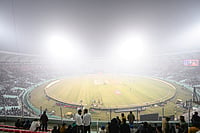As of now, we know about three dams that are of ‘run of the river’ (RoR) in design and operational in the mainstream of the Brahmaputra River, called the Yarlung Zangbo or Yarlung-Tsangpo or simply the Tsangpo in Tibet. These damns are part of the Zangmu, Dagu, Jiacha, and Jeixu hydropower projects.
We have learned that several such other hydropower projects are under construction, and about 11 dams will be functional by the end of this decade, including the gigantic Mutou hydropower project proposed to be constructed by China at the Great Bend on the Yarlung-Zangbo river which would generate a mammoth 60-70 gigawatt (60-70,000 megawatt) of power — more than three times the Three Gorges hydro project located on the river Yangtze in China, which is known as the World’s largest hydropower installation.
The mega Mutou project is situated about three kilometres away from the India-China border where the Tsangpo enters Arunachal Pradesh in the Upper Siang district and takes the name of Siang —or Dehang— river.
Since the RoR type dams do not retain water for a long time, they are not expected to result in drastic variation in flow in the Siang River or in the Brahmaputra River, which is formed by the three rivers — the Siang, the Dibang, and the Lohit in the eastern-most region of Assam. Since there is no damming of the mainstream Brahmaputra in India till now, Bangladesh is also not supposed to be affected.
However, in case of extreme rainfall occurring in the Tibetan part of the Tsangpo catchment or a landslide dam outburst flood being triggered there, sudden and unavoidable release of water from the dams may cause flash flooding in the Siang River in Arunachal Pradesh and Dhemaji district of Assam as well as the Brahmaputra further down in eastern Assam.
If the proposed mega dam is built by China in the Great Bend zone of the Namcha Barwa mountains, which is located close to the India-China border, the flow regime of the Tsangpo and hence of the Brahmaputra will be under full control of the Chinese authorities. They will be able to store the flow of the Tsangpo in reservoirs and divert or channelise the flow in another direction to carry the water to other regions as per their need. The amount and mode of release of water to the downstream channel of the Siang and consequently of the Brahmaputra will be decided to suit their interests and after prioritising the fulfilment of their requirements.
Such a situation is likely to cause reduction in the flow in the Siang and the Brahmaputra. The flow deficit will not be highly consequential in the rainy season since the Indian part of the Brahmaputra catchment, lying mostly in the Eastern Himalayan region, gets much more rainfall than the cold and dry trans-Himalayan parts of the central and western regions of the Yarlung-Zangbo river catchment in Tibet and therefore should generate enough run-off in these rivers in the Indian territory.
But the flows in the Siang and the Brahmaputra could significantly come down in the lean season if and when the flow from the Tsangpo River is stopped or only a miniscule of it is released to the Indian side of the river. The temporal and spatial aspects of such changes in the flow regime in downstream geographies is a matter of scientific estimation based on availability of relevant hydro-climatological data and reliable information about the hydropower projects and their dams existing in the upstream areas. Dwindling lean season flows may alter the pattern of sedimentation and reduce water levels in the plains of Assam, thus affecting navigation, agriculture, fisheries, wetlands, water supply, irrigation, and food security. The aquatic ecosystems, riparian biodiversity, and floodplain agricultural practices would be adversely impacted in India as well as in Bangladesh.
Another cause of concern is the acute seismicity of the region, which can pose a constant threat to any megastructure like the proposed Mutou dam. Many people do not know that on August 15, 1950, when Assam, Arunachal Pradesh, and other north-eastern parts of the Indian Himalayas were devastated by the 8.6 Magnitude Assam Earthquake — also known as the Assam-Tibet Earthquake, one of the biggest earthquakes ever recorded since the 20th century, widespread areas of Tibet lying in the Yarlung-Zangbo river basin were also severely affected and damaged. This included large-scale upheaval in the Medog (also called Mutou) county where the Great Bend on the Yarlung Zangbo lies.
The Great Bend is formed when the Tsangpo curls around the Namcha Barwa peak (7,782 meter) while descending from the high altitude near Pei (3,000 m), Tibet to the low-lying Himalayan slopes just before entering Arunachal Pradesh (600 m). Here, the Tsangpo forms the longest and the deepest canyon known as the Yarlung Zangbo/Tsangpo/Brahmaputra Grand Canyon. The Great Bend area, a part of the seismically extremely active Indus-Tsangpo Suture Zone, is also very highly prone to big landslides.
Any damage to the mega dam, if constructed here, will cause dam breaching and consequent flood havoc in India and Bangladesh. We have seen several incidents of natural damming of the Tsangpo and its tributaries following large-scale landslides leading to catastrophic to moderate flash flooding both in Tibet and downstream India — mainly in Arunachal Pradesh and Assam in the last three decades. Flash floods that occurred in the Yigong, a tributary of the Tsangpo, in the month of June 2000 that devasted many areas in the East Siang District Arunachal Pradesh and the Dhemaji District of Assam remains a classic example of catastrophic hydroclimatic disasters triggered in upstream Tibet region but suffered most in the downstream Indian region. Other similar incidents, but of lesser magnitude, happened in the years 2017, 2018, and 2021, giving rise to degradation of water quality and flooding in downstream Siang and the Brahmaputra. Such risks are on the increase given the susceptibility of the Himalayan region to climate change and its diverse impacts.
Since we do not have any bilateral or multilateral treaty or any other effective and formal instrument of understanding for collaborative management of the Yarlung Zangbo-Brahmaputra River between China and India, such interventions of herculean scale and size by China may result in unequal and inequitable sharing of water, water-induced risks of flash flooding, below-normal or low flow, triggering adverse effects like those mentioned above. To avoid rising of such occasions to indulge in hydro-hegemony by upper riparian countries sharing common water courses and aquatic resources, we direly need a formal muti-lateral mechanism leading to cooperation in transboundary water management among the countries sharing the Brahmaputra basin, viz. China, India, Bhutan, and Bangladesh.
Hydro-diplomacy should form an important ingredient of Indian foreign policy, especially as India shares river basins with neighbours. Our approach to hydro-diplomacy should be multipronged, comprising a combination of official government-led track 1 processes as well as unofficial initiatives following track 1.5, 2, and 3 efforts involving both national, regional, and global stakeholders drawn from non-state actors like scientists, researchers, civil society, and corporates.
Consistent engagement with an inclusive approach that can withstand the temporary jerks in bilateral diplomatic relations is what we need in principle for resolving conflicts and for mutual benefits from collaborative management of our shared rivers. The path to such a goal is of course full of challenges and time-taking, but there are quite a few examples in the world of conflicts being resolved and truce being achieved in transnational cooperation on rivers among countries that have a history of prolonged and intense contestations on riparian issues.
(Dr. Partha Jyoti Das is an interdisciplinary researcher of environment, society and development. He is Head, Water, Climate & Hazard Division, Aaranyak (Scientific and Industrial Research Organisation of India.)





















